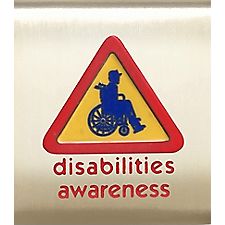This subject was added in 2009.
Requirements
Tiger Cubs, Cub Scouts, and Webelos Scouts may complete requirements in a family, den, pack, school, or community environment. Tiger Cubs must work with their parents or adult partners. Parents and partners do not earn loops or pins.
Belt Loop
Complete these three requirements:
- Visit with a friend, family member, classmate, or other person with disabilities. Find out what this person enjoys and what this person finds difficult.
- Attend a disabilities event such as an Easter Seals event, Special Olympics, a performance with sign language interpretation, an activity with Guiding Eyes dogs, or a wheelchair race. Tell your adult leader what you thought about the experience.
- Make a display about one or more disabilities. It can include physical, learning, or mental challenges. Share the display at a pack meeting.
Academics Pin
Earn the Disabilities Awareness belt loop, and complete five of the following requirements:
- People with disabilities move around in different ways such as crutches, scooters, and wheelchairs. Explain the differences. With an adult’s supervision and permission, try to safely use one.
- Using sign language, demonstrate the Cub Scout Promise and motto.
- Read a book about a person with a disability.
- Explain how your school helps students with disabilities (elevators, ramps, small classes, special tools and equipment, specialized teachers)
- Describe one of the following and its purpose: occupational therapy, speech therapy, or physical therapy. Visit with a person who works in one of these fields and learn about his or her position.
- Read about a famous person who has been physically or mentally challenged. Report what you learned to your den or family.
- For two one-hour periods, and with adult supervision, go about your
normal routine doing chores, watching television, studying, etc. Change
your abilities by using one of these experiences, then share what you
learned with your den.
- Hearing impairment — Muffle your ears with earmuffs or bandages.
- Sight impairment — Blindfold one or both eyes.
- Physical impairment— Bind an arm or leg so that it cannot be used.
- Speaking impairment — Cover your mouth or do not speak
- Choose an impairment of your own that is approved by an adult
- Look at a catalog and find three items that could help a person with disabilities in their daily life. Explain how each item would help the individual.
- Volunteer and help someone with disabilities in school, sports, or another supervised activity.
- Visit a nursing home or elderly person and help someone with a meal.
- Talk to someone who works with people who have disabilities. Ask what the person's position is like and how he or she helps people with disabilities.
| Worksheets for use in working on these requirements: | DOC File | PDF File |








